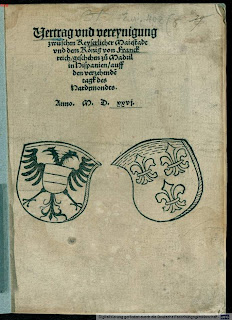These are not the only examples of helmets being used as symbols in Goetz's medals or the most striking. For instance, the most arresting design includes an assault helmet atop an erect penis to which a German maiden, Lorelei is chained, a bastard child and a broken lyre at her feet. But they are the images that reminded me the most of this image taken from Andrea Alciato's book of emblems published in Augsburg in 1531.
This woodcut illustrated the proverb Ex bello pax or Out of war comes Peace. The explanation of this suggested it be read in this way: "See here a helmet which a fearless soldier previously wore and which was often spattered with enemy blood. After peace was won, it retired to be used as a narrow hive for bees; it holds honey-combs and nice honey. - Let weapons lie far off; let it be right to embark on war only when you cannot in any other way enjoy the art of peace." Of course, a complete reversal of the sentiments of the twentieth century German examples above.
This sentiment seems to have originated with Alciato's emblem but it does recall many earlier precedents. One from the Bible that has turned up everywhere from Virgil (Georgics Book I) to Michael Jackson (Heal the World) is the idea of military weapons being turned to different purposes in Isaiah 2:4 or Micah 4:3 - "They will beat their swords into plowshares and their spears into pruning hooks. Nation will not take up sword against nation, nor will they train for war anymore."Similarly, it runs through classical literature with the spider being the most common occupant of old armour or weapons. 'In iron-bound shields are the looms of busy spiders' is a phrase of Bacchylides quoted by Plutarch (Numa 20); Euripides has a spear covered in cobwebs in Erectheus V. It's also found in Sophocles, Theocritus and, as mentioned in Roman literature in Virgil as well as Ovid (Fasti I.) Here, it is interesting to note a difference betwen Greek and Roman imagery, as suggested by James Hutton, that the Greek tradition uses the spider, whereas the Roman tradition uses the idea of ploughshares, and that these are combined only in the renaissance (Themes of Peace in Renaissance Poetry, 283.)
Slightly off-track: here's the image of Lorelei chained to the phallus:
I'm not just including this because I may have no opportunity to do so in the future, but also to illustrate certain a point. The image at first seemed to me to be quite ridiculous but the underlying sentiment is really quite disturbing. Goetz was commenting upon the use of black colonial French troops in the Rhineland and their alleged rape of German women. Why I'm including it here is that it occurred to me that some elements of the symbolism in this piece are also drawn straight from the renaissance emblem book. Here's Alciato once more, this time on discord.
This was used as an allegory for the peace of Italy in the 1531 edition. In subsequent ones it was titled Foedera, meaning a contract, agreement or treaty. The one broken string suggested, said Alciato's commentary, that "It is difficult, except for a man of skill, to tune so many strings, and if one string is out of tune or broken, which so easily happens, all the music of the instrument is lost and its lovely song disjointed. In like manner the leaders of Italy are now forming alliances.There is nothing for you to fear if affection lasts for you and stays in concord. But if any one should slide away, which we often see, that harmony is all dissolved into nothing." While we're on the subject, this sentiment has also recently topped the UK charts in a song by James Morrison featuring Nelly Furtado titled Broken Strings. When I first heard it I thought it was interesting that this imagery that I'd been reading about was still cropping up in pop music four centuries later, especially music with lines that have an audible clunk to them such as When I love you,/ It's so untrue...
I'm not going to include a link to that because it drives me nuts enough as it is, as it seems to get played almost every time I step into a public space. It's easy enough to track down if you feel like subjecting yourself to it. Why Don Henley in the title of this post? Well, if anyone's interested in a slice of musical masochism, here is a link to the song about Ronald Reagan by Bruce Hornsby, The End of Innocence, which Henley recorded in 1989. There's a fair few of the standard images/ tropes of the eighties music video used here: a couple rolling around in grassy fields; saxophone solo; nostalgia for the fifties; Henley doing what musicians seemed to do in clips all the time thirty years ago, namely standing in a field wearing a trench coat. But when he sings "they're beating ploughshares into swords, for the tired old man who we elected king" it reminds me - as it did when I saw Goetz's medals - that certain symbols seem to persist in many different contexts, that they can be deployed to say radically different things and that once you're aware of them you find them in very odd places.
Once again, you can find a catalogue of Goetz's work here and can explore Glasgow University's excellent digital version of Alciato's Emblematum liber with a click here or the other excellent site here at MUN in which many editions are cross-referenced here.
NAHC


















